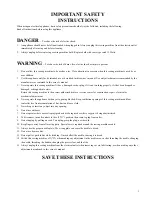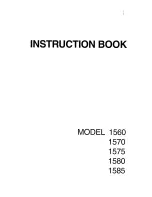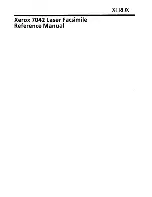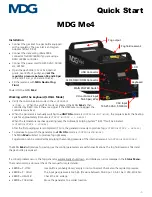
Umbau und Erweiterung des Ejektors vorbereiten
1.
Nehmen Sie die Gesamtanlage so außer Betrieb, wie es in der Gesamtanleitung
der Anlage beschrieben ist.
2.
Schalten Sie die Anlage drucklos und spannungsfrei.
ECS erweitern
Ejektor mit Kabelsatz ECS (Luftsparautomatik) erweitern.
O
Siehe Kabelsatz ECS austauschen unter Kapitel 8 „Demontage und Austausch”.
Optionales Zubehör
O
Kabelsatz ECS, siehe Ersatzteile unter Kapitel 7 „Instandhaltung und
Instandsetzung”.
11 Fehlersuche und Fehlerbehebung
12 Technische Daten
Ejektor
Die technischen Daten finden Sie im Internet unter
www.aventics.com/pneumatics-catalog.
Drucksensor
Siehe
W
BDL, Drucksensor PE3-P2 (2 x PNP), R412004321
W
BDL, Drucksensor PE3-PV (1 x PNP + 1 x analog), R412004326 oder
W
im Internet unter www.aventics.com/pneumatics-catalog.
English
1
About this documentation
These instructions contain important information for the safe and appropriate use of
the product.
O
Read these instructions carefully, especially section 2 “Notes on Safety”, before
working with the product.
Additional documentation
O
Follow the instructions for the other system components.
O
Also observe the following instructions:
– System documentation from the system manufacturer
– Operating instructions, PE3-P2 pressure sensor (2x PNP), R412004321
– Operating instructions, PE3-PV pressure sensor (1x PNP, 1x analog),
R412004326
O
Furthermore, observe general, statutory and other binding rules of the European
and national laws, as well as regulations to protect the environment and avoid
accidents.
Störung
mögliche Ursache
Abhilfe
Vakuumniveau wird
nicht erreicht oder
Vakuum wird zu
langsam aufgebaut
Filter verschmutzt
Filter reinigen bzw.
austauschen
Schalldämpfer verschmutzt Schalldämpfer austauschen
Leckage im Schlauch
Schläuche und
Schlauchverbindungen
überprüfen
Leckage am Sauggreifer
Sauggreifer überprüfen
Betriebsdruck zu gering
Höheren Betriebsdruck
einstellen
Schlauchdurchmesser
innen zu klein
Schlauchdurchmesser
prüfen (siehe „Ejektor:
Druckluft und Vakuum
anschließen“)
Nutzlast kann nicht
festgehalten werden
Hysterese zu klein
Größere Hysterese einstellen
Sauggreifer zu klein
Größeren Sauggreifer
auswählen
Luftsparautomatik
schaltet Vakuum nicht
aus
Schaltpunkt liegt über dem
max. Vakuum
Höheres Vakuum erzeugen
oder niedrigeren
Schaltpunkt einstellen
Luftsparautomatik
schaltet Vakuum nicht
ein
Hysterese größer als
Schaltpunkt
Höheren Schaltpunkt oder
kleinere Hysterese
einstellen
Luftsparautomatik
funktioniert nicht
Kabel oder Adern
vertauscht
Kabel und Adern richtig
anschließen
(siehe „Elektrische
Versorgung anschließen”)
Presentation of information
Safety instructions
In this document, there are safety instructions before the steps whenever there is a
danger of personal injury or damage to equipment. The measures described to avoid
these hazards must be observed.
Structure of safety instructions
Meaning of the signal words
Symbols
2
Notes on Safety
The product has been manufactured according to the accepted rules of current
technology. Even so, there is a risk of injury or damage if the following general safety
instructions and the specific warnings given in this instruction manual are not
observed.
O
Read these instructions completely before working with the product.
O
Keep these instructions in a location where they are accessible to all users at all
times.
O
Always include the operating instructions when you pass the product on to third
parties.
Intended use
The product is exclusively intended for installation in a machine or system or
combination with other components to form a machine or system. Use is permitted
only under the operating conditions and within the performance limits listed in the
technical data.
W
Only use the ejector to generate a vacuum in pneumatic systems.
Intended use includes having completely read and understood these instructions,
especially section 2 “Notes on Safety”.
Improper use
W
Do not use the ejector in explosive areas.
W
Do not suction any liquids, aggressive or flammable gases, or bulk materials
(e.g. granules).
Personnel qualifications
Assembly, commissioning and operation, disassembly, service (including
maintenance and care) require basic mechanical, electrical, and pneumatic
knowledge, as well as knowledge of the applicable technical terms. In order to
ensure operational safety, these tasks may only be carried out by qualified personnel
or an instructed person under the direction of qualified personnel.
Qualified personnel are those who can recognize possible hazards and institute the
appropriate safety measures due to their professional training, knowledge, and
experience, as well as their understanding of the relevant regulations pertaining to the
work to be done. Qualified personnel must observe the rules relevant to the subject area.
General safety instructions
W
Observe the applicable local regulations to protect the environment in the
country of use and to avoid workplace accidents.
W
Only use AVENTICS products that are in perfect working order. Examine the
product for obvious defects, such as cracks in the housing or missing screws,
caps, and seals.
W
Do not modify or convert the product.
W
The warranty will not apply if the product is incorrectly assembled.
W
Do not place any improper mechanical loads on the product under any
circumstances.
Safety instructions related to the product and technology
During assembly
W
Make sure the relevant system component is not under pressure or voltage
before assembling or when connecting and disconnecting plugs. Protect the
system against being switched on.
SIGNAL WORD
Hazard type and source
Consequences of non-observance
O
Measures to avoid hazards
CAUTION
Indicates a hazardous situation which, if not avoided, could result in minor or
moderate injury.
NOTICE
Indicates that damage may be inflicted on the product or the environment.
Operation may be impaired if this information is disregarded.
AVENTICS
| ECS | R412004317–BDL–001–AE | Deutsch/English
5







































